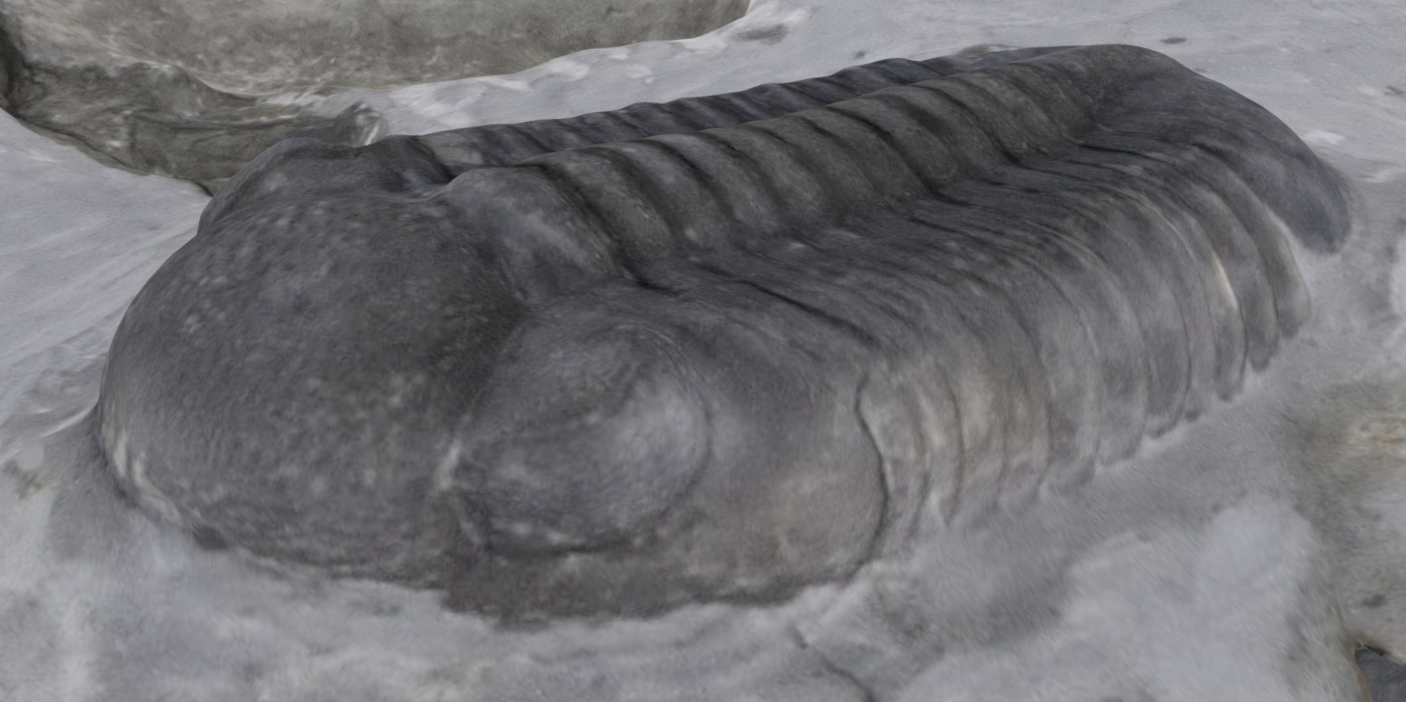
Some 370 million years ago, an ancient seaway covered much of what is now western and central New York state. Abundant animal life lived in this ancient sea and some of these species left behind fossils that can be found in the corresponding Devonian-aged rocks exposed today in gorges, road cuts, and quarries.
Below are interactive 3D models of some representatives of this diverse ancient fauna. These models were created using a process called photogrammetry, which involves using specialized software to effectively stitch together 100+ images of an individual object (photographed at all angles) to create an interactive 3D representation of that object. All of the specimens shown below are from the research collections of the Paleontological Research Institution, Ithaca, New York. Each model was created by PRI Digitization Assistant Emily Hauf.
You can load individual models by clicking on them. Once loaded, you may interact with the model at full-screen size by clicking on the corresponding button in the lower-right corner.
You may access 3D models of fossils from other regions and time intervals here: https://sketchfab.com/DigitalAtlasOfAncientLife.
This page by: Jonathan R. Hendricks. Last updated August 12, 2022.
Phylum Porifera
Porifera are sponges. These simple animals live attached the seafloor. They gather particles of food from the water by pumping the water through their porous bodies.
Class Hexactinellida ("Glass Sponges")
This group of sponges create lattice-like skeletons made out of silica. Therefore, they are sometimes called "glass sponges."
While gorgeous examples of glass sponges have been found in the Devonian of New York, they are very rare.
Hydnoceras tuberosum from the Devonian of Steuben County, New York (PRI 76741). Length of specimen is approximately 26 cm.
Fossil glass sponge Uphantaenia chemungensis from the Devonian of Spencer, New York (PRI 49852). Specimen is from the collections of the Paleontological Research Institution, Ithaca, New York. Longest dimension of specimen is approximately 23 cm. Model by Neil Pezzoni.
Phylum Cnidaria
Cnidarians include jellyfish, sea anemones, corals, and other animals. All use specialized stinging cells to capture their prey. Corals often produce mineralized exoskeletons and therefore have an excellent fossil record.
Class Anthozoa
Anthozoa is the grouping of cnidarians that includes the corals and sea anemones.
Order Tabulata: Tabulate Corals
Tabulate corals are extinct. They originated in the Ordovician period and went extinct at the end of the Permian period. Many species have shapes suggestive of honeycombs. They are defined by the presence of tabulae: small, horizontal plates that form vertical separations within individual corallites.
Emmonsia emmonsii from the Devonian Onondaga Limestone of Genesee County, New York (PRI 76736). Longest dimension of specimen is approximately 8.5 cm.
Favosites tuberosus from the Devonian Onondaga Limestone of Erie County, New York (PRI 54955).Longest dimension of specimen is approximately 12 cm.
Favosites sp., encrusted by auloporids, another kind of extinct coral. Specimen is from the Devonian Ludlowville Formation of Genesee County, New York (PRI 76739). Longest dimension of specimen is approximately 10.5 cm.
Fossil tabulate coral Pleurodictyum convexum from the Devonian Onondaga Limestone of New York (PRI 49862). Specimen is from the collections of the Paleontological Research Institution, Ithaca, New York. Longest dimension of specimen is approximately 10 cm. Model by Neil Pezzoni.
Order Rugosa: Rugose Corals (or, "Horn Corals")
Solitary members of the Rugosa often have shapes that resemble the horns of bulls; they are therefore called "horn corals." Some species, however, formed large colonies. Rugose corals are extinct; they originated in the Ordovician period and went extinct at the end of the Permian period.
Heliophyllum halli from the Middle Devonian Moscow Formation of Erie County, New York (PRI 70755). Specimen is approximately 11 cm in length.
Heliophyllum sp. from the Middle Devonian Ludlowville Formation of Genesee County, New York (PRI 5541). Specimen is approximately 9.5 cm in length.
Fossil rugose coral Heliophyllum delicatum from the Devonian of Central New York (PRI 50359). Specimen is from the collections of the Paleontological Research Institution, Ithaca, New York. Longest dimension of specimen is approximately 23 cm. Model by Neil Pezzoni.
Phylum Brachiopoda
Brachiopods were much more diverse and common in the past than they are today. They live attached to surfaces on the seafloor and filter the food they need from passing water. Because they have two valves, they are sometimes mistaken for bivalves (Phylum Mollusca), but are not at all similar in terms of their soft part anatomy.
Brachiopods are the most commonly encountered Devonian fossils in New York state.
Class Lingulata
Order Lingulida
Fossil brachiopod Lingula delia (PRI 77399) from the Devonian Windom Shale of Madison, New York. Specimen is from the collections of the Paleontological Research Institution, Ithaca, New York. Longest dimension of specimen is approximately 4.9 cm (whole slab) / 2 cm (shell only). Model by Neil Pezzoni.
Class Strophomenata
Order Strophomenida
Fossil brachiopod Strophodonta demissa from the Devonian Hamilton Group of Wanakah, New York (PRI 44210). Specimen is from the collections of the Paleontological Research Institution, Ithaca, New York. Longest dimension of specimen is approximately 4.2 cm. Model by Neil Pezzoni.
Class Rhynchonellata
Order Spiriferida
Brachyspirifer audaculus from the Middle Devonian Moscow Formation of Livingston County, New York (PRI 70767). Longest dimension of specimen is approximately 5 cm.
Spinocyrtia granulosa from the Devonian Ludlowville Formation of Erie County, New York (PRI 70764). Longest dimension of specimen is approximately 6.5 cm.
Fossil brachiopod Macropleura macropleura from the Devonian New Scotland Limestone of Schoharie, New York (PRI 50326). Specimen is from the collections of the Paleontological Research Institution, Ithaca, New York. Longest dimension of specimen is approximately 5 cm. Model by Neil Pezzoni.
Shale sample with abundant fossils of the brachiopod Ambocoelia umbonata (PRI 83732) from the Devonian Moscow Formation (Windom Shale Member) of Moravia, New York. Longest dimension of specimen is approximately 11.4 cm (whole slab). Model by Neil Pezzoni.
Order Rhynchonellida
Tullypothyridina venustula from the Devonian Tully Limestone of New York State (PRI 70762). Longest dimension of specimen is approximately 2.5 cm.
Order Athyridida
Athyris spiriferoides from the Devonian Ludlowville Formation of Erie County, New York (PRI 44050).
Order Atrypida
Spinatrypa spinosa from the Devonian Hamilton Group of Erie County, New York (PRI 70769). Diameter of specimen is approximately 4 cm.
Order Orthida
Fossil brachiopod Rhipidomella penelope from the Devonian Ludlowville Formation of Wanakah, New York (PRI 44061). Specimen is from the collections of the Paleontological Research Institution, Ithaca, New York. Longest dimension of specimen is approximately 3.7 cm. Model by Neil Pezzoni.
Phylum Mollusca
Mollusks are a diverse phylum and have a superb fossil record. This is especially true for the three largest classes of mollusks: bivalves, gastropods, and cephalopods.
Class Bivalvia
Bivalves include clams, scallops, and oysters. Like many other marine invertebrates, bivalves filter the food they eat from the passing water.
Grammysia elliptica from the Devonian Ithaca Formation of Tompkins County, New York (PRI 76731). Longest dimension of specimen is approximately 5.5 cm.
Grammysia bisulcata from the Devonian Skaneateles Formation of Onondaga County, New York (PRI 76730). Length of specimen is approximately 6.5 cm.
Grammysioidea arcuata from the Devonian Hamilton Group of Herkimer County, New York (PRI 76729). Longest dimension of larger valve is approximately 5.5 cm.
Class Gastropoda
Gastropods include snails and slugs. They are not commonly encountered in the Devonian of New York relative to many other groups.
Platyostoma gebhardi from the Devonian of Schoharie, New York (PRI 76747). Longest dimension of specimen is approximately 3.5 cm.
Naticonema lineata from the Devonian Hamilton Group near Geneseo, New York (PRI 76749). Maximum dimension of specimen is approximately 3.5 cm.
Fossil gastropod Palaeozygopleura hamiltoniae from the Devonian Skaneateles Formation of New York state (PRI 49889). Specimen is from the collections of the Paleontological Research Institution, Ithaca, New York. Longest dimension of specimen is approximately 5 cm (whole slab) / 3 cm (shell). Model by Neil Pezzoni.
Class Cephalopoda
Squids, octopuses, and the chambered nautilus are all examples of modern cephalopods. Cephalopods are active predators and swim through the water to find their food. The diversity of shelled cephalopods was much greater during the Devonian than today, which is represented only by Nautilus.
Order Nautilida
Casteroceras alternatum from the Devonian Marcellus Shale (Cherry Valley Limestone Member) of Madison County, New York (PRI 5363).
Tetranodoceras transversum from the Marcellus Shale (Cherry Valley Limestone Member) of Cayuga County, New York (PRI 5365). Model by Emily Hauf.
Order Pseudorthocerida
Spyroceras sp. from the Devonian of Onondaga County, New York. Length of specimen is approximately 4.5 cm.
Order Ammonoidea
Holotype of the cephalopod Agoniatites intermedius (PRI 5370); from the Devonian Cherry Valley Limestone of Cayuga County, New York.
Fossil ammonoid Manticoceras sinuosum from the Devonian Cashaqua Formation of Yates County, New York (PRI 49803). Specimen is from the collections of the Paleontological Research Institution, Ithaca, New York. Longest dimension of specimen is approximately 6 cm. Model by Neil Pezzoni.
Tornoceras uniangulare from the Devonian Geneseo Shale of Tomkins County, New York (PRI 55004). Maximum diameter of specimen is approximately 6 cm.
Phylum Arthropoda
Arthropoda is the most diverse animal phylum and includes insects, spiders scorpions, barnacles, crabs, shrimp, and other forms. The Arthropoda also includes a variety of completely extinct groups. All arthropods have an external skeleton and jointed appendages.
Class Trilobita
Trilobites--named for the three lobes of their thorax region--are very well represented in the Devonian of New York and are a favorite among collectors. This group of arthropods is now completely extinct; they originated in the Cambrian period and went extinct at the end of the Permian period.
Eldredgeops rana from the Devonian Ludlowville Formation of Genesee County, New York (PRI 49811). Trilobite specimen is approximately 3 cm in length.
Dipleura dekayi from the Middle Devonian of Hamilton, New York (PRI 68155). Specimen is approximately 15 cm in length.
Fossil trilobite Greenops boothi (PRI 83729) from the Devonian Moscow Formation of Tompkins County, New York. Specimen is from the collections of the Paleontological Research Institution, Ithaca, New York. Longest dimension of specimen is approximately 9.7 cm (whole slab) / 3.3 cm (trilobite only). Specimen also includes a well-preserved spiriferid brachiopod (?Mucrospirifer sp.). Model by Neil Pezzoni.
Fossil pygidium of trilobite Bellacartwrightia whiteleyi (PRI 83731) from the Devonian Deep Run Shale of Canandaigua, New York. Specimen is from the collections of the Paleontological Research Institution, Ithaca, New York. Longest dimension of specimen is approximately 5.3 cm (whole slab) / 3.6 cm (trilobite only). Model by Neil Pezzoni.
Phylum Echinodermata
Class Crinoidea
Crinoids are relatives of starfish that live on the seafloor and gather food particles from the water using their long arms. Fossil remains of crinoids are most often preserved as disarticulated stem fragments.
Melocrinus williamsi from the Devonian Ithaca Formation of Cortland County, New York. Specimen preserves mineralized hard parts (stem segments) and external molds of stem segments and the calyx. Rock slab is approximately 29 cm in length.


